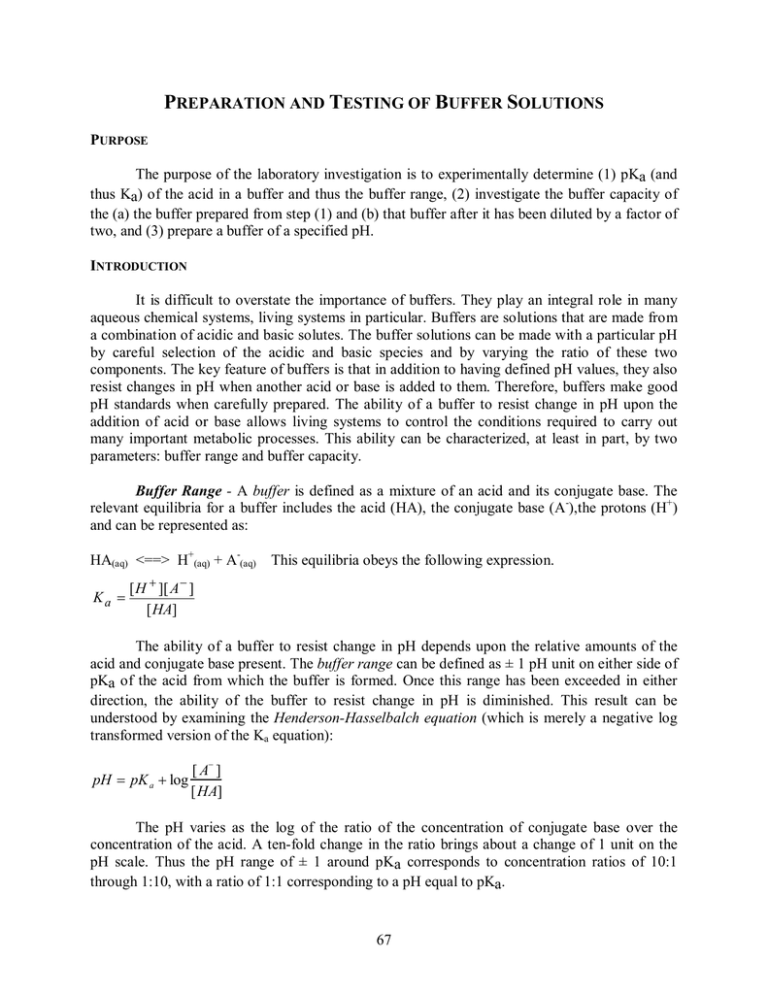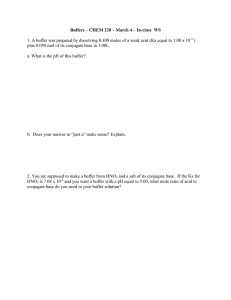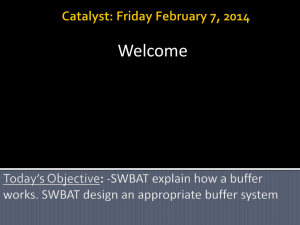P T B S
advertisement

PREPARATION AND TESTING OF BUFFER SOLUTIONS PURPOSE The purpose of the laboratory investigation is to experimentally determine (1) pKa (and thus Ka) of the acid in a buffer and thus the buffer range, (2) investigate the buffer capacity of the (a) the buffer prepared from step (1) and (b) that buffer after it has been diluted by a factor of two, and (3) prepare a buffer of a specified pH. INTRODUCTION It is difficult to overstate the importance of buffers. They play an integral role in many aqueous chemical systems, living systems in particular. Buffers are solutions that are made from a combination of acidic and basic solutes. The buffer solutions can be made with a particular pH by careful selection of the acidic and basic species and by varying the ratio of these two components. The key feature of buffers is that in addition to having defined pH values, they also resist changes in pH when another acid or base is added to them. Therefore, buffers make good pH standards when carefully prepared. The ability of a buffer to resist change in pH upon the addition of acid or base allows living systems to control the conditions required to carry out many important metabolic processes. This ability can be characterized, at least in part, by two parameters: buffer range and buffer capacity. Buffer Range - A buffer is defined as a mixture of an acid and its conjugate base. The relevant equilibria for a buffer includes the acid (HA), the conjugate base (A-),the protons (H+) and can be represented as: HA(aq) <==> H+(aq) + A-(aq) This equilibria obeys the following expression. [ H + ][ A − ] Ka = [ HA] The ability of a buffer to resist change in pH depends upon the relative amounts of the acid and conjugate base present. The buffer range can be defined as ± 1 pH unit on either side of pKa of the acid from which the buffer is formed. Once this range has been exceeded in either direction, the ability of the buffer to resist change in pH is diminished. This result can be understood by examining the Henderson-Hasselbalch equation (which is merely a negative log transformed version of the Ka equation): [ A− ] pH = pK a + log [HA] The pH varies as the log of the ratio of the concentration of conjugate base over the concentration of the acid. A ten-fold change in the ratio brings about a change of 1 unit on the pH scale. Thus the pH range of ± 1 around pKa corresponds to concentration ratios of 10:1 through 1:10, with a ratio of 1:1 corresponding to a pH equal to pKa. 67 Buffer Capacity (also β or buffer intensity) is a measure of the ability of a buffer to resist changes in pH. The larger the buffer capacity, the greater the resistance to pH change. Where buffer range is determined by the ratio of conjugate acid and base species present in the buffer mixture, buffer capacity can be related to the magnitude of these concentrations. The definition of buffer capacity is: β= dCb − dC a = dpH dpH where dCb and dCa are the changes (prior to reaction with the buffer) in the number of moles of protons or hydroxides per liter of buffer and dpH is the change in pH caused by these changes. By examining the Henderson-Hasselbalch equation above, it is easy to see that this parameter varies with pH. Maximum resistance to change in pH is found nearer to pKa. EQUIPMENT Each student pair will be issued the following: (1) a pH meter and electrode, (2) a 25 mL buret and buret clamp, (3) a solid unknown acid, (4) adequate quantities of standardized base (NaOH) solution, and (5) access to other laboratory glassware as needed. PROCEDURE Make sure you calibrate your pH meter! Record the information on your solid unknown’s container, dissolve the unknown acid in distilled water, and dilute to volume in a 250 mL volumetric flask. The number of moles of acid contained in the flask (and thus the acids concentration) is of no major concern. You will be concerned only with the relative amounts of acid and its conjugate base present in your buffers. Finding Ka - Pipet 25 mL of your unknown acid solution into a 125 mL E. flask. Pipet another 25 mL into a 150 mL beaker. Assuming you have pipetted carefully, I think you will agree that each vessel contains the same number of moles of acid. Now add 3 drops of phenolphthalein indicator to the E. flask and titrate to the first faint pink that persists (after swirling) for 30 seconds. Record the volume of base required. The acid in the E. flask has now been converted into the conjugate base of the acid. If you have titrated properly, I think you will agree that the number of moles of base in the E. flask is equal to the number of moles of acid in the beaker. Now pour the contents of the E. flask into the beaker, pour some back into the E. flask to rinse it, and pour the contents back in the beaker (repeat once more if you feel it is needed to ensure complete transfer). Now I think we can agree that the beaker contains a mixture of an acid and its conjugate base in equimolar ratios - i.e. it is a buffer. Thus, according to the Henderson-Hasselbalch equation, the pH of this solution is equal to pKa of the acid. Carefully measure the pH of the buffer and calculate Ka of the acid. Show the result to your instructor. 68 Testing water - (a) Pipet 10 mL of distilled water into a large test tube. Measure the pH. Add 0.10 mL of 0.10 M HCl and measure the pH again. (b) Pipet 10 mL of distilled water into a large test tube. Measure the pH. Add 0.10 mL of 0.10 M NaOH and measure the pH again. Testing the Buffer (full-strength) - (a) Pipet 10 mL of the buffer prepared in the first part of the experiment into a large test tube. Measure the pH. Add 0.10 mL of 0.10 M HCl and measure the pH again. (b) Pipet 10 mL of the buffer prepared in the previous step into a large test tube. Measure the pH. Add 0.10 mL of 0.10 M NaOH and measure the pH again. Testing the Buffer (1/10 strength) - (a) Measure 5.00 mL of buffer prepared in the previous step into a beaker and add 45 mL of distilled water into the beaker - mix. Pipet 10 mL of the resulting diluted buffer into a large test tube. Measure the pH. Add 0.10 mL of 0.10 M HCl and measure the pH again. (b) Pipet 10 mL of your diluted buffer step into a large test tube. Measure the pH. Add 0.10 mL of 0.10 M NaOH and measure the pH again. Again, verify the validity of your results by either comparing with neighbors (their results will not match yours exactly, but they should exhibit consistent trends) or by conferring with your instructor. If the results appear to be odd, it is a good idea to repeat the procedures in doubt. Preparing a Buffer of Known pH - Consult the information you copied from your unknown’s container. Using the Henderson-Hasselbalch equation and the pKa value determined in the last section find the ratio of base to acid needed to prepare a buffer of the pH specified on your unknown’s container. Pipet 25 mL of the unknown acid solution into a clean 125 mL E. flask. Pipet another 25 mL into a clean 150 mL beaker. Both vessels contain equimolar amounts of acid. Add 3 drops of phenolphthalein indicator to the E. flask and titrate to the first faint pink that persists for 30 seconds. Record the volume of base required. The acid in the E. flask has now been converted into the conjugate base of the acid. Now clean out your buret thoroughly and fill it with distilled water. Add a volume of distilled water to the acid in the beaker equal to the volume of NaOH added to the acid in the E. flask. Now we can agree that the E. flask and the beaker contain equimolar amounts of acid and conjugate base in equal volumes - i.e. the two vessels contain solution of acid and conjugate base of equal concentrations. Now, calculate the volume of each solution needed to create the ratio of base to acid calculated at the beginning of this section. Consult with the instructor to verify your numbers. Prepare your buffer and confirm the pH using the pH meter (record the result). Show the result to the instructor . . . the instructor will evaluate your work and discuss with you how you can further fine-tune the pH of your buffer. Make the suggested adjustments and retest the buffer pH. REPORT Complete the report form (see website). Make sure to include all data and calculations that impact on the determination you have performed. 69 PRELAB Buffers Spring 2012 • • • 1. 2. For short answers, construct clear and concise answers using complete sentences, proper spellings, and correct grammar. For reactions, include all physical state subscripts AND balance the equations. For calculations, show complete problem set-ups, include units, and report answers with the proper number of significant digits. What is a buffer? Of what types of chemical species are buffers composed? A buffer is made from ammonia, Kb=1.8x10-5, and ammonium chloride. It has a pH = 9.00. (a) Which buffer component is present in larger amounts, ammonia (NH3) or ammonium ions (NH4+)? (b) Which buffer component (NH3 or NH4+) would neutralize HCl that was added to the buffer? Write the neutralization reaction. c) What buffer component (NH3 or NH4+) would neutralize NaOH that was added to the buffer? Write the neutralization reaction. (d) Consider the buffer described in part (a): (i) If the [NH3] = 0.50 M, what is [NH4+] for the pH of the buffer to be 9.00? (ii) If 0.010 mole of NaOH(s) is added to 1.00 L of the buffer just described in (d)(i), what is the new pH? 70






